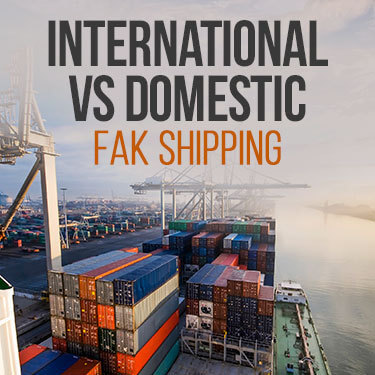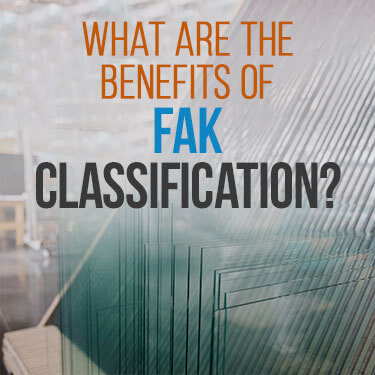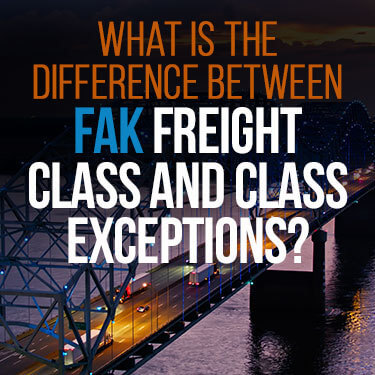Someone looking for ways to better manage their shipping costs might come across the term FAK shipping. But, what does FAK mean in shipping services? Why does it appear so often as a solution for reducing high shipping costs? See why FAK, or Freight of All Kinds, is a service you want to know about as a shipper for local and international needs.
The Dictionary of International Trade recognizes FAK as a common abbreviation for Freight of All Kinds. It’s a term used by freight forwarders when pricing containers or pallets for clients shipping different commodities in one order. Providing a FAK shipping quote is usually faster than one based on individual commodities.
Consider how FAK classification is impacted by shipping methods and when it can help your business the most.
As a logistics term, FAK stands for Freight of All Kinds. In shipping, a load with a FAK classification is made up of different commodities and gets charged a flat rate.
There aren’t any set Federal or international regulations on which commodities carriers can provide FAK classification for. Guidelines for FAK shipping depend greatly on whether the freight is moving by ocean, truck, or rail. These industries each treat FAK a little differently and will quote rates based on factors unique to that particular shipping system.
For shippers using several modes of transportation, this means a FAK classification may change as the cargo moves down the supply chain. This is especially true when cargo is being moved between ship, truck, and rail services.

Both international and domestic shipping services rely on systems that organize commodities by type, purpose, or size. These systems exist to provide standardization and a common language among carriers.
On the international side, ocean freight rates are based on:
In the United States, freight transport rates are based on:
If you want to take rail lines into consideration, flat rates are the most common. Partial shipments use Standard Transportation Commodity Codes (STCC) to classify separate items.
With a system already in place, you may be wondering why a separate freight classification system is even needed. The truth is that while the FTL and FCL pricing is very clear and straightforward, partial shipment pricing involves the use of specific data that may change from shipment to shipment.
The submission of specific dimensions, weights, and commodity codes required for pricing means LTL and LCL quotes are data intensive. The more data a carrier needs to process, the more time-consuming rate calculations are.
Classifying a shipment as FAK allows it to be treated as a single commodity without having to take into account varying weight, volume, or densities created by multiple items.
When arranging shipping services, be aware that a FAK description doesn’t automatically get you a different rate. Recall that there are no standards for FAK rate determination - each carrier sets its own or can choose to not offer it all.
International shipping has become standardized thanks to the development of the Harmonized System (HS) of codes. These codes are specific to thousands of commodities and help importers and exporters pay the proper duties and tariffs.
Ocean carriers don’t usually negotiate directly with customers, especially for high-variety shipments. The use of Non-Vessel Operating Common Carriers (NVOCC), also known as consolidators, makes FAK rate negotiations possible for international shipments.
When you’re examining freight rates in the U.S., it’s common to hear the term tariff being applied to domestic shipping. This is not a tax. Domestic carriers use the term tariff to indicate which shipping rates have nationally standardized prices.
There are two classification systems for commodities in the U.S. that double as price standards.
When shipments are sent out and priced as FAK, the rate is usually based on the mean range of items being transported. Of course, this is only possible with full disclosure of the items being shipped.
If you have a container coming in from Singapore and the cargo on the Bill of Lading is only described as FAK, the next carrier is going to request specifics. This helps you and the carrier avoid any nasty surprise penalties.
Knowing the exact items in a shipment gives carriers the ability to inform you about possible restrictions at the state and federal levels.

Since FAK descriptions are up to individual carriers, the best way to determine a shipment’s qualification for a FAK description is to ask the carrier.
As far as freight terms are concerned, FAK covers a broad range of cargoes. Carriers are naturally wary of an “All Kinds” description because they can’t be sure that goods have been organized and packaged correctly.
Before you ask about FAK rates, consider taking the following steps.
The special rates often provided to FAK shipments are usually far more beneficial to a shipper than to a carrier. Commodity-specific shipments do generate more revenue. Carriers that do provide FAK rates, especially for LTL, are only going to do so if they can count on that customer for multiple shipments.
If you are someone only looking to ship one order, one time, a FAK classification that provides a reduced price isn’t likely. This is true no matter what the items in the shipment are.
Once you do have a relationship with a carrier, developing good packaging habits is also going to improve your chances of being granted FAK status.
LTL and LCL shipping can get complicated because there are so many options. When things arrive at their destination, you want to make sure your shipments can be managed efficiently. Cargo that is always a hassle to move because of bad packaging or poor organization isn’t just going to make warehouse workers upset - it’s a safety hazard for all involved.

There are situations where FAK descriptions are useful. They have the ability to simplify various parts of the shipping process. To take full advantage of the benefits, you need to meet certain criteria.
Shippers that benefit the most from FAK classification are those who ship a variety of commodities with high frequency.
Some of the best benefits include:
If you are no longer able to maintain your frequent shipping practices, speak with your carrier or freight broker and they may offer other alternatives. If you are growing your business or are looking for a way to consolidate some shipments, a long-term relationship with a carrier helps.
Posting your needs to shipping boards in the hopes of a decent spot rate is more likely to drive up the price of shipping.
Being able to go with an “if it fits, it ships” type of service, does have benefits. For some shippers, it’s a great solution when freight shipping variety. However, there are some negatives shippers need to acknowledge.
The same things that make FAK convenient can get you in trouble in certain circumstances.
There are individuals who try to take advantage of generalized freight labels to ship things they shouldn’t. Because of this history, a skid or container with FAK status has a greater chance of being pulled for a spot inspection.
At best, this is just a delay and might put a delivery back a few hours. At worst, things could get damaged or some other kind of mistake is revealed, such as a missing HazMat label for that one barrel of industrial cleaner being included with your shipment of hospital supplies. Now you have a delay and a penalty fee of a few thousand dollars depending on the severity of the error.
Shipping mistakes happen. Pallets break, trucks crash, and containers sometimes fall overboard in the middle of the Pacific. This is why freight insurance and liability are available.
However, in a FAK shipment, your coverage limit is reduced to match the negotiated rate. Consider this sample FAK shipment and related values. The order below might be from a company freight shipping medical supplies in bulk to care facilities.
| Commodity | Average Item Value* | Possible Freight Class |
| Surgical Tape | $0.50 | 60 |
| Wound Dressings | $4.00 | 100 |
| Antiseptic Spray | $8.00 | 100 |
| Disposable Gloves | $25.00 | 100 |
| Crutches | $50.00 | 150 |
| Feeding/IV Pumps | $700 | 200 |
| Portable Oxygen Concentrator | $4,000.00 | 250 |
Some medical supplies are pretty cheap and hard to damage. A box of surgical tape isn’t likely to get damaged if it falls suddenly or even gets a little damp. Electronics, on the other hand, like IV pumps or oxygen machines are expensive and delicate. Electronics also command a much higher freight class than gauze or gloves.
A carrier that agrees to ship an order like this as FAK rather than by commodity might quote you the average weight and density rate of the whole shipment - perhaps Class 150. The higher the class, the more expensive shipping is so you are still getting a break on the oxygen machines.
By taking the lower average, you are giving up the right to claim the full value of your shipment in case of damage or total loss.
Let’s say there were five of those $4,000 oxygen machines in a total loss shipment. That would be $20,000 worth of equipment and you might only get back a fraction of that.
This is an oversimplified example, but it does reveal the potential for loss if the items you ship together are not well selected or well packaged.

True FAK rates in the shipping industry aren’t common, especially in the trucking industry. Ocean carriers are a little different because of the massive amounts of containers they can carry. Charging a per container FAK rate rather than commodity rates helps them reach capacity faster.
Ocean carriers also don’t use Freight Class or NMFC codes - they operate on the HS system when they do charge by commodity.
A true FAK classification means your cargo is shipping for a flat rate, with no adjustment to account for density ranges. This is nearly impossible for trucking companies to agree to at an LTL level. For an FTL shipment, it’s possible since your cargo wouldn’t have to share space.
A class exception is a carrier’s own rule for pricing freight between specific classes. These class exceptions are up to the carrier and ranges will vary between different companies.
| Freight Class Range | Treated As… |
| 50 - 100 | Class 70 |
| 110 - 200 | Class 150 |
| >200 | Actual Class |
These are examples and might not accurately reflect a company’s policies, but they do show that there are limits. Most carriers will let clients know there is a limit. If any part of your shipment goes above that limit, then that part must be shipped at the actual class tariff rate.
Commodity-specific shipping has plenty of benefits over FAK, especially as shipment value goes up. It isn’t just about getting items from point A to point B. You want to make sure that items arrive in the same condition they started in.
Exploring different shipping options gets overwhelming once you realize just how many options there really are. At the end of the day, you want to make sure you are doing right by your business and your customers.
Here at USA Truckload Shipping, we feel the same way. Our representatives are industry experts who can guide you through all sorts of freight classifications including FAK.
We will make sure you get the best services for the right price no matter what you need to move.
If we can’t move it, we will find someone who will. Call us today at (866) 353-7178 to speak with some now. You can also request an online quote today and be ready for shipping even sooner.
R+L Global Logistics
315 NE 14th St., Ocala, FL 34470